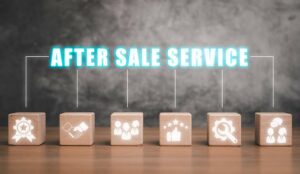As customers, it’s happened to all of us — we fall in love with a brand, we make a purchase and then…radio silence. No follow-up, no check-ins, no support when we need it most.
Studies show that 83% of consumers drop a brand after just one bad customer service experience — the majority of these instances possibly come after conversion.
That’s why consistent after-sales support must stay in rhythm. Selling to a customer is like winning a game of chess — you need to think several moves ahead to stay ahead of the competition.
After-sales service is like the endgame strategy that helps you conquer cohesive, lasting relationships with your customers.
In turn, people who have positive after-sales experiences are more likely to make repeat purchases, leave great reviews and boost your revenue through positive word-of-mouth.
Aksheeta Tyagi at Sprinklr dives into the importance of after-sales support and share some real-world examples of companies getting it right, and also explores tips and strategies on how to make sure your customers are always happy, long after they’ve converted.
What is After Sales Service?
After-sales service refers to the ongoing support and assistance that a business provides to customers after they have purchased a product or service.
It includes resolving customer complaints, offering technical support, providing maintenance services, and addressing product issues or defects.
When your customer service and customer-facing departments like marketing and sales work in sync, delivering the best after-sales service becomes easier.
From chatting with a salesperson to finally converting and seeking support from an agent, customers expect seamless, delightful conversations.
After all, delight is the fourth stage of a marketing funnel after conversion. Pleasing your customers with the best after-sales service is critical for maintaining strong customer relationships, fostering brand loyalty, and retaining more customers — all of which results in positive word-of-mouth.
By providing exceptional after-sales service, businesses can create a competitive advantage and stand out in the marketplace.
shows customers that the business cares about their satisfaction beyond the initial purchase and is committed to delivering ongoing value.
Why is After Sales Service Important?
Your present customers carry great potential to be your biggest advocates and drivers of revenue.
The only way to make that happen is to ensure their perception about your brand stays high, long after they’ve bought from you.
Your customer response times must stay low and every resultant interaction valuable. Nearly 90% of customers contemplate ditching a business that delivers unhappy customer service — so sidelining the importance of after-sales service isn’t an option.
Visualize a leaky bucket. Because it’s compromised, you can put all the water in the world and it will keep oozing from the holes.
After-sales support is like fixing that leaky bucket so your customers never even think of abandoning your brand.
Best after-sales service increases the probability of customers buying from you again, thus becoming repeat customers in the long term.
Like how marketing can be credited with bringing in new customers, quality after-sales support ensures higher lifetime value (LTV) of your customers.
Businesses need after-sales service to reap these four benefits:
1. Word-of-Mouth Referrals
Happy customers are valuable assets because they almost always refer your brand to family and friends.
Positive word-of-mouth from satisfied customers can drive up to 50% of a business’ total sales. Not just that, satisfied customers have a 16% higher lifetime value.
Since a majority of new business comes from referrals, delivering superior after-sales service significantly increases the number of customers willing to provide referrals.
2. Positive Brand Image
Almost nine out of 10 customers read reviews before making a purchase and negative customer reviews hurt even the most well-known brands.
Recent studies have shown that excellent post-purchase experiences attract positive reviews, slowly enhancing the overall brand image. Being seen as a trustworthy and helpful brand is essential to improve customer stickiness.
3. Customer Loyalty
A great product with poor customer support is a tragedy. However, when backed by excellent customer service, pre-and post-sale, an average product does exceedingly well.
The purpose of after-sales service is to increase loyalty among customers and make them your brand advocates.
Engage your customers regularly, equip them with helpful resources, and ensure your offering makes their life easier. It will enhance customer satisfaction and retention.
4. Increase in Revenue
Humans are creatures of habit. Existing customers spend more than new customers. If you treat your customers well and become a part of their life, they will keep returning to your brand.
In addition, most happy customers become brand loyalists who also bring in new customers — driving sales and revenue.
Your Ticket to Delightful CX
Customer retention is a long game to play. And especially tricky when your customers have faced issues after they’ve bought from you.
the phase when they’re highly perceptive and need a reason to keep trusting you. The experience you deliver then is a golden chance to build trust that remains untethered.
And that hinges on meticulous customer experience planning.
5 Types of After-Sales Service
Here are a few after-sales service types that can help your brand retain more loyal customers.
1. Usage-Related Assistance
Provide customers guidance on using the product or service to get the most bang for their buck.
Maybe your product is not turnkey or it needs reinstallation, initial usage-related assistance is crucial.
From remote product configuration to troubleshooting tips, valuable assistance enables customers to use your offering more effectively.
2. Assurance
Let the customer know that if the purchased product is defective or isn’t working properly, it can be returned or exchanged.
Warranty, guarantee, upgrades, returns, and replacement policies are examples of assurance that can instill a sense of trust and confidence in users.
3. Support
Be available to address customer queries or complaints on online and offline channels. Despite your efforts to demystify usage-related issues, your customers will still need access to prompt, on-demand customer support.
Study your users’ post-sale behavior and design self-service solutions to empower them to find answers to common issues. Deploy 24×7 omnichannel customer service to enable your customers to contact you whenever, they want to, wherever they want to.
4. Rewards
Delight customers with loyalty rewards, special offers, and the latest updates regularly. Customers who engage with your business consistently need applause.
Reward them with exclusive perks, free giveaways, or first access to new offerings. For tech products, your customers may also appreciate a free upgrade or no-cost repairments.
5. Education
Educate customers via live demo sessions or pre-recorded explainer videos. Maybe your product uses nuanced technology or has under-utilized features that your users need to pick up pace with.
Take stock of the most common hindrances they face while leveraging your offering. This could help you more consciously design learning guides for them — whether they are tutorial videos, apps, or presentations.
Pro Tip
You need to be sure you’re dispelling the right doubts. Sharpen your educational content with solid conversation analytics software that helps you do that.
This cool tool studies your customer interactions to extract key contact drivers and query trends.
With this insight, you can create content that directly targets specific challenges your customers are facing, improving self-service, making your support even more relevant and effective.
5 Examples of After-Sales Service
Here are five examples of after-sales services to get inspired by and improve your brand perception.
1. Lenovo Gets Usage-Related Assistance Right
Lenovo, one of the world’s leading computing device manufacturers, offers after-sales service in the form of an application called Lenovo Vantage.
The app makes it easier for Lenovo users to manage device settings, run diagnostics, update drivers and enhance their PCs.
It enables them to detect and troubleshoot issues on their own and reach out to the Lenovo support team in case they need further assistance.
Lenovo designed it to ensure users get to enjoy three benefits with their product – extended battery life, automated PC updates through expert support and a proactive warning system to prevent network mishaps.
2. Ikea Takes Product Education a Notch Up
Ikea is a best-selling furniture brand whose assembly instructions have had a long history of giving customers nightmarish experiences.
Users often felt out of the loop when it came to assembling furniture parts into something workable.
The Swedish furnishing brand took notice of this problem and created an entire playlist of how-to videos on YouTube.
These videos are highly detailed and complement the written instructions that come with the furniture, allowing their customers to assemble the parts easily.
The playlist ranges in educational content — such as tips and ideas, how-to-organize, how-to-install, how-to-decorate and more.
Pro Tip
Give your customers a space to find answers on their own. Use knowledge base software to build a strong repository of content that answers most queries that pop up in their heads — only needing your team to get in action in complex situations that need human oversight.
3. Apple Safeguards Your Products Like No Other
Apple covers the cost of manufacturing defects for up to a year from the date of purchase via AppleCare.
Ninety days of complementary technical support is also provided after purchase. Apple customers can even extend the warranty period of their products by purchasing AppleCare coverage.
AppleCare reflects the brand’s commitment to producing high-quality products and rendering even better quality service.
With Apple’s warranty program, customers can conveniently access in-person or mail-in repairs and receive technical support from Apple’s team for troubleshooting software-related issues. The warranty is also transferable, in case a user resells their product or buys a new one.
4. Shopify’s Customer Support Turns Frowns to Smiles
A lot of e-commerce companies provide online support for product-related queries. Shopify, a leading e-commerce platform, is known for its impeccable customer service.
They’ve identified the channels their customers prefer and implemented their after-sales support services across those channels.
For instance, Shopify has a dedicated Twitter account to resolve customer queries.
All their patrons have to do is tweet their problems and mention @Shopify and they’ll receive immediate assistance.
The e-commerce platform also uses its social handle to dispel doubts about new updates and features by promoting its knowledge base and help articles.
Moreover, Shopify is prompt and proactive when it comes to troubleshooting time-sensitive issues that hinder its users’ experience with the platform.
5. Barnes & Noble Ensures Reading Pays Off Well
Popular book-selling platform Barnes & Noble runs a paid loyalty program. Customers can join this program for an annual fee of $39.99 and get upgraded as VIP members.
These VIP members receive a 10% discount on every purchase. When customers check out at Barnes & Noble, they are asked whether they are loyalty program members.
If they are, they get a 10% discount — no questions asked. If a customer isn’t, the checkout staff explains the program’s benefits and asks them if they’d like to enroll.
Since Amazon became popular, bookstores have struggled to keep up with the online giant’s price-cutting strategies.
But the Barnes & Noble loyalty program and similar initiatives by publishers and bookstores have driven engagement and sales despite stiff competition from Amazon.
Best Tips to Master After-Sales Service in Business
A lot of work goes into acquiring a customer. Why let it go in vain because of not following up with the customer post their purchase? For customers to return to your brand, building long-lasting relationships is key. And here are a few ways to accomplish it:
- Send customers a thank you note and invite them to your store launches and brand events.
- Provide them with the information on how to make the most of their purchase.
- Ask for their feedback.
- Engage with them regularly and on special occasions. For instance, wish them on birthdays and anniversaries, enroll them in reward programs, etc.
- Keep them posted on the latest offers and discounts.
Brands must be available to their customers when and where they need them. But the problem is that customer service is broken.
Due to numerous customer service channels and ever-evolving customer preferences, keeping track of customer needs is challenging.
Access to the right technology can help track and cater to rapidly changing buying behavior. It would help if you had a solution to help your team handle large volumes of tickets, including post-sale customer inquiries.
And that’s where a Unified Customer Experience Management (Unified-CXM) platform, which uses AI and automation to manage customers across different channels, comes in handy.
Frequently Asked Questions
What Training Should Staff Receive to Provide Effective After-Sales Service?
To provide effective after-sales service, the staff should be trained in these customer service skills:
- Troubleshooting technical problems
- Driving cross-sells and upsells
- Customer relationship handling
- Conflict resolution
How Can AI Improve After-Sales Service Processes?
AI can automate after-sales processes like order handling, tracking returns/exchanges and product recommendations based on order/browsing history of the customer.
How Often Should After-Sales Service Policies be Reviewed and Updated?
At least once a year to keep pace with changing customer expectations and market trends. More frequently if customer feedback indicates a need to revamp after-sales policies.
What is the Impact of After-Sales Service on Brand Reputation?
Effective after-sales service can drive positive word of mouth, referrals and enhanced brand reputation, giving your business a definitive competitive advantage.
Conversely, poor after-sales service can dent your brand reputation and result in negative customer sentiment, satisfaction and loyalty.
Author: Guest Author
Published On: 10th Jun 2024 - Last modified: 23rd Oct 2024
Read more about - Guest Blogs, Aksheeta Tyagi, Sprinklr















